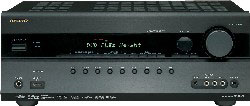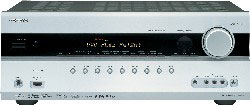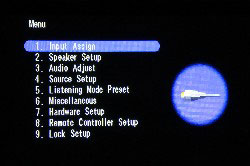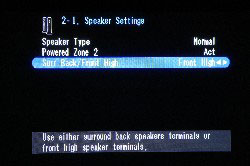Introduction
I have to admit, I’m a sucker when it comes to having the latest and greatest toys. As my wife can attest, I’m always looking for excuses that will allow me to spring for that next upgrade. In recent years, Onkyo has been at the forefront of new A/V receiver technology and features, releasing new models at an almost breakneck pace in order to stay one step ahead of the competition. The TX-SR607 continues that technological advance as the first product in the world to sport Dolby Pro Logic IIz. Pro Logic IIz is a new processing algorithm that derives left and right front “height” channels from our current surround soundtracks and music. Of course, these new height channels require additional speakers, which make a move to Pro Logic IIz a potentially expensive upgrade. As I was anxious to see if these new “height” channels really added to the listening experience or were just another gimmick, I tore into the 607’s box as soon as it arrived.
Specifications
- Design: 7.2 (2 Subwoofer Outputs) Channel A/V receiver
- Codecs: All Dolby and DTS surround codecs, including Dolby TrueHD and DTS-HD Master Audio, Dolby Pro-Logic IIz
- Power: 90 Watts x 7 into 8 Ohms
- THD+N: 0.08% with 2 Channels Driven
- Audyssey Processing: 2EQ, Dynamic EQ, Dynamic Volume
- Inputs: 6 HDMI 1.3a (1 Front Panel), 2 Component Video, 5 Composite Video, 2 Optical Digital, 2 Coaxial Digital, SIRIUS Radio, Onkyo R1 Control
- Outputs: 1 HDMI 1.3a, 1 Component Video, 1 Composite Video, Analog L+R for Zone 2, 2 Subwoofer Outputs
- Dimensions: 6.9″ H x 17.1″ W x 12.9″ D
- Weight: 23.8 Pounds
- MSRP: $599 USA
- Onkyo
Design
First impressions tend to stick with you, and the TX-SR607 cuts a fairly sharp silhouette with its real aluminum face panel (available in either black or silver). The front panel design is very clean and easy to operate with dedicated source buttons, a navigation joy pad (yes, you could actually set up this unit without the remote if need be), and buttons for other useful things like display panel dimming and listening mode selection. There is also a 1/4″ headphone jack, auxiliary audio input, a stereo mini-jack for iPod-type devices, and a jack for the Audyssey calibration microphone. Special mention needs to be given to the inclusion of a full-size HDMI 1.3a input on the front panel. Thank you Onkyo! I hope this is the start of a trend in the industry, as temporarily plugging in an HDMI-equipped camcorder, camera, or video game console is infinitely easier with the front panel jack.
Moving around back, we see that Onkyo is expecting the 607’s purchasers to have pretty up-to-date gear. HDMI is definitely the preferred hook-up method, with the 607 sporting five HDMI 1.3a inputs and one output. This should prove to be more than adequate for just about anyone in the $600 price range. There are two component video inputs and one output.
There is not a single S-video input, though Onkyo still felt it was necessary to include five composite video inputs. Personally, I would trade three composites for an additional component input, but that’s just me (I’ve still got three component-only devices in my rack).
The 607 sports Faroudja’s DCDI processing and scaling for analog sources, with HDMI being simply pass-through from the source. Two optical digital and two coaxial digital audio outputs are included for non-HDMI equipped digital components, and should prove adequate for most consumers. There are also two subwoofer pre-outs, which is a rare but very welcome feature. There are five-way binding posts for the main seven channels of amplification, but the Zone 2 channels get stuck with wimpy-looking spring-clip terminals. Not only are they a very flimsy connection, they also require very thin wire. I had trouble getting 14 Gauge (the smallest I had lying around) bare wire into the clips securely. Since adding binding posts would probably have cost all of $1, I was pretty disappointed by this omission. Overall build quality was solid, and met my expectations considering the list price.
I do have a few observations with respect to the connectivity options on the 607. There is no RS-232 jack for custom control systems, but that is most likely not a big deal for a receiver of this price. There is also no IR input jack, which is very handy if you need to hide your gear in a closet or equipment rack or use an RF to IR blaster. There is also no switched AC outlet, though I’m probably one of the few people who still use one (to trigger the bias light behind my plasma). A multi-channel pre-out is not included either, so anyone with plans of connecting the 607 to a higher-powered amp down the road must look elsewhere in Onkyo’s lineup.
Also, I was surprised by the lack of a 5.1/7.1 multi-channel analog input. Not only does this alienate almost every multichannel SACD/DVD-Audio player (like my Pioneer Elite DV-47Ai), it also means that you can’t use the analog outputs of a Blu-ray player. Granted, HDMI bit-streaming would be the preferred setup in most cases, but having the player decode the audio is still the only sure way to get all secondary audio and menu sounds off of a Blu-ray disc without degrading the signal in some way. As Onkyo has obviously designed this player for today’s tech-savvy market, the absence of either a USB input or Ethernet jack is surprising. But, Onkyo does include the UP-A1 iPod dock, which allows full control of your iPod from the receiver.
Remote and Setup
The remote for the TX-SR607 is all I would expect given the receiver’s price point. The remote is usable, with direct source input buttons and basic universal capabilities. The buttons are small and are nearly impossible to find in the dark, as the remote is not back lit, nor do the buttons glow in the dark. The overall button layout was pretty good and I had no problems with the receiver responding to commands, even from extreme angles. The only odd quirk I noticed was that once you press one of the direct input buttons (say DVD/BD), the remote switches to that mode and will no longer operate any of the functions of the receiver except volume. You will need to press the “receiver” mode button if you wish to send commands to the 607 again.
Setting up the 607 proved to be relatively easy. I plugged my Samsung Blu-ray/HD-DVD player into HDMI1, my cable box into HDMI2, and used the two component video inputs for my Wii and Pioneer Elite DVD/SACD player. Then I went into the Onkyo’s intuitive onscreen menu to associate the appropriate audio/video jacks to the sources and I was done. Or so I thought. For some reason, the 607 would not accept the video signal from my Motorola 6208 HD PVR box. I kept getting HDCP content protection errors that would shut off the video signal after about two seconds. The problem could lie within the DVI-to-HDMI converter cable that I use, but I have used this exact same cable/cable box combo directly connected to two different HDTVs without a single glitch. I suspect that there may be a compatibility issue at play here. The product manager suggested obtaining an updated cable box to resolve my compatibility issue.
Since I couldn’t get around the HDCP error, I simply used component video for the cable box. I had to “steal” a component connection from my Pioneer player, but since I use my Blu-ray player for all movie watching anyway, this was not too big of an issue. The 607 functions as an HDMI pass-through device only and during the course of my review I did not notice any degradation of HDMI-based signals. The Faroudja chip set is merely average when it comes to analog video scaling/de-interlacing, with the Coliseum flyover scene on the “Gladiator” DVD showing the “jaggies,” a clear sign of poor 3:2 pull down.
The only other issue I had with setup revolved around the height channels. From reading the manual, it looked like the height channels needed to be hooked up to the spring-clip terminals (labeled “front high”) on the back of the receiver. This allowed me to keep my back surround speaker hooked up to the “back surround” terminals, which would make switching between a traditional 7.1 setup and a 5.1 + “height channel” setup easy. But this is not how the 607 works. The product manual does not include the instructions but the product manager did provide the instructions to me in an e-mail:
“This is possible, but not when Powered Zone 2 is set to “Active”. (Note that the photo above, of the set-up menu, shows the Zone 2 setting as “active”.) Set Powered Zone 2 to “Not Active”, then you can wire up traditional 7.1 and Front High channels. Then the channels being used will be determined by the listening mode (ie PLIIx will utilize surround back channels and no front high, PLIIz will utilize front high channels and no surround back.”
When setting up the unit, you must decide if you are going to use back surrounds or height channels, and hook those speakers up to the “back surround” binding posts. From the speaker setup menu, activate the second zone amplifier and then select “front high.” This same set of binding posts will also allow you to bi-amp your main front speakers if you only want to run a 5.1 setup. Just change the second zone amplifier setting to “bi-amp.” The spring clips only work for Zone 2 speakers.
The 607 uses Audyssey’s 2EQ automatic calibration system, which starts up automatically when you plug in the included microphone. Following the simple onscreen instructions, I let 2EQ measure the sound from three different places (the maximum that 2EQ allows) and it hit speaker distance and levels spot on the first time around. The onscreen menus really simplify this setup process, so make sure that you have your TV connected before running the Audyssey calibration. Once Audyssey is done, don’t forget to save your results. From there, you can go back into the 607’s onscreen menu and enable Audyssey Dynamic EQ and Dynamic Volume if you choose. I am a big fan of Dynamic EQ, which compensates for the weaker bass and surround effects exhibited during low volume level listening, so I turned it on immediately. Dynamic Volume is great for keeping sound levels within a specific volume window, but I feel it compresses the overall sound too much, so I left it off for the whole review process.
In Use
Music and Surround Sound


I always start evaluating any new component with music, as I firmly believe that if a piece of gear can do 2-channel music well, it will sound great with all music and surround sound formats. After disabling the Audyssey equalization, I started my listening session with some of my favorite CD tracks. Rachmaninoff’s “Symphonic Dances” (Reference Recordings, RR-96) sounded very good on the 607. Overall tonal qualities were neutral, with the 607 leaning towards neither the bright nor warm side of things. Soundstaging was fairly expansive, with the Onkyo providing a solid idea where each instrument was placed on the stage. The midrange was very smooth and balanced nicely with the treble. Massed string instruments cut through the mix without being overly harsh. Next, I moved onto “Azucar” (Avalon – B00000J6Z0) and cued up track 4, “Dusk.” The drum kicks were tight and accurate, and the Spanish guitar remained smooth and balanced. The winds that come in later in the track sounded beautiful.
As I’ve experienced with other Audyssey equipped devices, enabling the Audyssey 2EQ improved all aspects of 2-channel listening. Overall frequency response became more balanced, soundstaging and imaging improved, and bass performance tightened up. The only gripe I have with Onkyo’s Audyssey implementation is that they do not allow a user to access the “flat” equalizer curve. This equalizer curve is expressly designed to present a completely flat frequency response at the primary listening position. For 2-channel listening, this has consistently proven to be my personal favorite, though that could be a result of my room’s acoustics. Onkyo does allow for the creation of a custom Audyssey EQ curve, but without being able to see the equalizer results recorded during the Audyssey calibration it is difficult to figure out where to start. Putting aside the lack of Audyssey “flat,” I was extremely impressed with the 607’s 2-channel performance and am simply amazed that this level of sound quality is available today at the $600 price point.




Moving into surround sound, I ran through a battery of blu-ray test discs, including “Ratatouille,” “The Fifth Element,” “The Matrix,” and “Mad Men: Season 2.” The lossless surround tracks on each disc sounded great, particularly with Audyssey enabled. I also preferred keeping Dynamic EQ turned on, which increases bass impact and surround sound levels when you are listening at less than reference level. Dialog intelligibility was excellent, as was the overall surround sound envelopment. Bass impact was solid without bloating and there was a very neutral presentation in the midrange and treble. The 90 watts of advertised power at 8 Ohms seemed to be spot on, and the 607 had no trouble driving my system to satisfactory volume levels.
One thing I did notice was that if you feed the 607 a 192 kHz signal, Audyssey correction is automatically disabled. It turns out that the Onkyo lacks the processing power to decode the 192 kHz signal and apply Audyssey processing simultaneously. As we are starting to see more music only Blu-ray discs with 192 kHz tracks (like 2L’s fantastic sounding “Divertimenti”), I hope that Onkyo addresses this problem in their next generation of products. Despite this minor criticism, the 607 once again seemed to perform above its price range and I can’t imagine any buyer being disappointed in its surround sound performance.
How about those Height Channels? As I’m sure I’ve annoyed quite a few readers by not yet mentioning the height channels, let me give them their own separate section. This was my first experience with height channels and Dolby Pro Logic IIz, so I spent a good deal of time experimenting with speaker placement and setup. At least from my own testing, I found that I preferred keeping the height channels at least two feet farther apart than my front mains. This seemed to increase the amount of “ambiance” that the height channels produced, and kept the height channels from “smearing” the sound coming from my front mains. I tried a few different speaker heights as well, eventually settling on about 24 inches from the ceiling in my media room. This put the height channels about 3 feet above the tops of my front tower mains.
Also, I found that I had to add 3-4dB worth of additional volume to the height channels to get the best effect. Anything more than +4dB seemed to create a little too much ambiance, almost like turning on the “reverb” feature on a guitar amplifier. I highly recommend a user experiment with the positioning and level of the height channels, as every room will produce different results. Using speakers that are voice-matched to your front mains and center channel is highly recommended as well.
Once I had the height channels set up to my liking, I enabled Pro Logic IIz processing and tried out my demo CDs again. I will be upfront and state that I’ve never cared for Pro Logic IIx processing with stereo sources, and Pro Logic IIz did nothing to change my opinion. Yes, the height channels helped to produce a wider soundstage with more “air,” but it just sounded way too artificial for my taste. I also noticed a definite loss of musical detail and clarity with IIz engaged, almost like I was listening to the music through a “haze.”
Moving on to movie soundtracks, I found myself torn about the height channels’ effectiveness. Pro Logic IIz really adds a neat effect to movie scenes where there is rain or running water in the mix. For example, during the introductory scene of “Ratatouille” I really liked how IIz helped make the falling rain sound almost like the real thing. During “The Matrix,” the sprinklers going off as Neo and Trinity attempt to free Morpheus sounded awesome. However, I didn’t think that all surround tracks benefited from IIz. Dolby recommends the well known “Diva” scene from “The Fifth Element” as a great way to hear the benefits of IIz. While the height channels expanded the front sound stage, I once again heard a bit of “haze” over the sound, similar to what I heard when applying IIz to stereo music sources.
Switching back and forth between IIz and the Dolby TrueHD listening mode confirmed this for me. There was a subtle loss of clarity in the front three channels with IIz processing enabled. Going back to my earlier test scenes from “Ratatouille” and “The Matrix,” I was able to hear the same thing. Granted, the differences in sound were minor, but they were audible if you listened closely. I can only venture that the additional processing was responsible for this slight loss of detail and clarity. In summary, the height channels work really well with certain material and I’m intrigued by the potential for expanding the front sound stage and ambiance of surround soundtracks. I’m also now very interested in hearing how Audyssey’s forthcoming DSX processing will handle height sounds. I’m even more excited in seeing truly “discrete” height/ambiance channel effects. Can anyone say “DTS-HD High Master Audio” or “Dolby Truly High HD?” Someone make sure I get my royalties on these.
Conclusions
During the course of this review, I had to continually remind myself that this was only a $599 receiver. The core performance of the 607 on 2-channel audio and movie soundtracks is simply excellent and should satisfy all but the most discerning “audiophile.” The inclusion of Audyssey Dynamic EQ and Dynamic Volume (for those of you not allowed to “crank up” your systems) are welcome additions, as are the six HDMI connections. My few criticisms of the 607 are minor and most likely will not be of concern to the intended buyer. As for Pro Logic IIz, I personally wouldn’t upgrade a relatively new receiver or pre-processor just to get the height channels, though they do help add extra ambiance on movie soundtracks. The bottom line is this: you need to pay quite a bit more money to dramatically improve upon the performance of the TX-SR607. That is high praise indeed and if $600 is within your receiver budget the Onkyo TX-SR607 is tough to beat.








